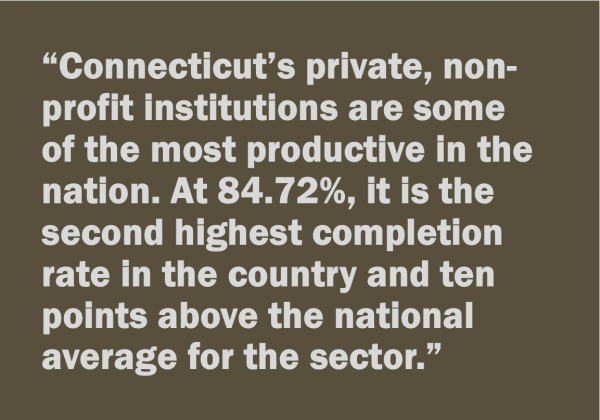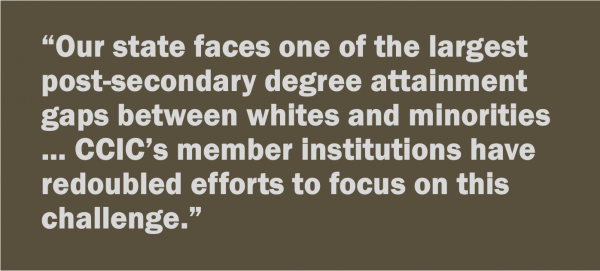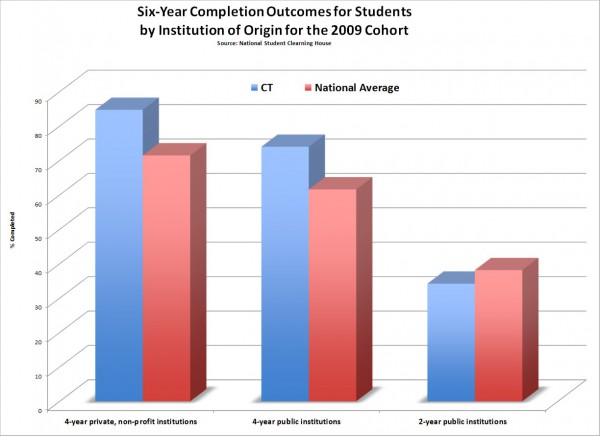PERSPECTIVE: CT Independent Colleges Among National Leaders in Student Completion; Working to Reduce Disparities
/by Jennifer Widness
Recent news coverage labeling Connecticut’s private, non-profit institutions of higher education as “drop-out factories” is a flawed conclusion based on incomplete data and requires additional scrutiny. While more always can and should be done to improve the outcomes for low-income students in our higher education system, Connecticut’s private, non-profit colleges have made this issue a priority and in fact are among the nation’s leaders in completion rates for all students.
First, let’s address the limitations of the data used in the report. To conduct their analysis, the authors from the Washington, D.C. think tank, the Third Way, used data compiled for the U.S. Department of Education’s College Scorecard. As the authors noted in their study, but the reporter failed to mention, this data set only includes full time, first time students that have received a federal loan. This accounts for less than 40% of the undergraduate students enrolled at these institutions. There is no accounting for students that transfer, in or out, or a student that has taken a semester off and returned. Given the evolution of how people access higher education, th is is a significant omission.
is is a significant omission.
Graduation rates are complicated and hard to calculate given limited access to good data but the National Student Clearinghouse is the most complete data set available as it does have the capacity to track transfer students. As illustrated in Figure 1 below, it recently calculated the 6-year completion rate for students that began at a four-year private, non-profit institution in Connecticut at 84.72%. This is the second highest completion rate in the country and ten points above the national average for the sector (20 points above the national average for the 4-year publics). Connecticut’s private, non-profit institutions are some of the most productive in the nation.
Further, the authors misappropriated the term “dropout factories” by applying it to institutions with graduation rate of 75% or less. This is a threshold used for K-12 schools by the U.S. Department of Education. If all higher education institutions with a graduation rate of less than 75% using data compiled by the College Scorecard were considered “dropout factories” nearly all institutions in Connecticut, public and private, would fall into that category. See for yourself here.
Nuances with the data and terminology used in this particular report aside, average completion rates in all sectors of higher education across do need to be improved. While Connecticut’s higher education institutions have some of the highest completion rates in the country, our state faces one of the largest post-secondary degree attainment gaps between whites and minorities. The authors of the Third Way are right to point out that high-risk populations need greater access to higher education. We agree.
This has been a priority, and always will be, for Connecticut’s independent colleges.
CCIC’s member institutions have redoubled efforts to focus on this challenge by providing more resources to student support services, increasing financial aid to unsustainable levels and creating innovative programs that support a diverse student body to enroll, persist and complete college.
The state, on the other hand, also needs to  play a greater role in this area. Why? Connecticut’s Strategic Plan for Higher Education lays it out perfectly. In essence, our economy will increasingly require a talented, well-educated workforce to thrive and the only way to guarantee this talent pool exists is to ensure our state residents have access to and complete a post-secondary education. While severe budgetary constraints exists given shrinking revenues, we cannot afford not to do a better job in coordinating this work across all sectors of higher education and the workforce.
play a greater role in this area. Why? Connecticut’s Strategic Plan for Higher Education lays it out perfectly. In essence, our economy will increasingly require a talented, well-educated workforce to thrive and the only way to guarantee this talent pool exists is to ensure our state residents have access to and complete a post-secondary education. While severe budgetary constraints exists given shrinking revenues, we cannot afford not to do a better job in coordinating this work across all sectors of higher education and the workforce.
Connecticut is fortunate to have some of the best, most productive and diverse public and private higher education institutions in the country. Labeling them inappropriately is untrue – and even worse unproductive. These institutions are some of our state’s greatest assets. If we want to see Connecticut grow and thrive again we have to capitalize on our strengths and put these institutions to work.
____________________________________
Jennifer Widness is President of the Connecticut Conference of Independent Colleges.
PERSPECTIVE commentaries by contributing writers appear each Sunday on Connecticut by the Numbers.
Also of interest… Do Community College Students Go Begging?





























